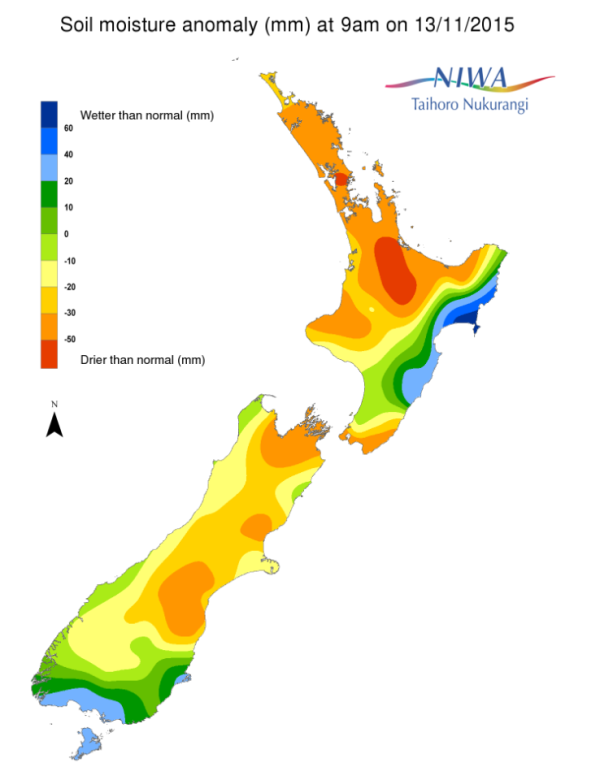A weekly update describing soil moisture across the country to help assess whether severely to extremely dry conditions are occurring or imminent. Regions experiencing these soil moisture deficits are deemed “hotspots”. Persistent hotspot regions have the potential to develop into drought.
Facts: Soil Moisture
For the North Island, soil moisture levels have decreased or remained mostly unchanged compared to this time last week. The exception to this is Gisborne and Hawke’s Bay which has seen moisture levels trend to wetter than normal for this time of year. The driest soils are in the central and eastern Waikato to Bay of Plenty as well as areas of northern Auckland, southern Northland and coastal South Wairarapa where soil moisture levels are much drier to severely drier than normal for this time of year.
In the South Island, soil moisture levels have decreased or remained largely unchanged compared to this time last week. Soil moisture levels from the eastern Tasman through to nearly all of Marlborough are severely to extremely drier than normal for this time of year. Farther south, and east of the Divide, most areas from northeast Canterbury far northern Otago soil moisture levels are experiencing much drier to severely drier than normal for this time of year, with pockets of extremely drier than normal soils for this time of year. The remainder of the island continues to experience near normal soil moisture conditions, with slightly wetter than normal soils for this time of year about coastal Southland from Fiordland to Invercargill.
Outlook
For the North Island, after a dry Saturday, rain is expected to fall over much of the island, with the greatest chances/amounts likely south of the Auckland region. More rain is likely to occur Monday, in particular, central and northern parts of the island. Thereafter, there is uncertainty as to what unfolds. While there is confidence that additional showers will fall, exactly where is not as certain. Early indications are that central and eastern areas of the island may have the greatest threat for showers for the middle portion of next week with possibly a late week cold front bringing another threat for showers island-wide Thursday and/or Friday.
Consequently, soil moisture levels are likely to remain the same or possibly increase for central portions of the island with soil moisture levels holding steady or decreasing for other regions.
For the South Island, rainfall distribution will be largely influenced by the Southern Alps. Along and west of the Divide, rainfall over the next seven days is expected to be generous with amounts tapering off significantly east of the Divide, especially about the coast from near Dunedin to near Blenheim. As a result, soil moisture levels are likely to remain the same or increase for locations west of the Divide for the Southland to West Coast regions. The rest of the South Island will likely have soil moisture levels remain steady or decrease by this time next week.
Hotspots persists in eastern Waikato and adjacent to the Auckland/Northland regional boarder. For the South Island, hotpsots exists in eastern Marlborough as well as eastern Canterbury from about the Waiau River to near Christchurch. With another sizeable hotspot located from near Oamaru to Timaru, west to the Waitaki and Mackenzie Districts.
Background:
Hotspot Watch a weekly advisory service for New Zealand media. It provides soil moisture and precipitation measurements around the country to help assess whether extremely dry conditions are imminent.
Soil moisture deficit
The amount of water needed to bring the soil moisture content back to field capacity, which is the maximum amount of water the soil can hold.
Soil moisture anomaly
The difference between the historical normal soil moisture deficit (or surplus) for a given time of year and actual soil moisture deficits.
Dry and extremely dry soil
Definitions: “Extremely” and “severely” dry soils are based on a combination of the current soil moisture status and the difference from normal soil moisture.
Check out NIWA's soil moisture maps
Soil Moisture Anomaly Maps
Pictured below soil moisture anomaly maps, relative to this time of year. The maps compare last week’s soil moisture anomaly with today’s.


